Bezugsquelle

Anschrift: Fábrica Nacional de Moneda y Timbre, c/ Jorge Juan, 106 , 28071 Madrid
Telefon: +34 915 666 535
E Mail
Website: Shop
Sprache: Spanisch, Englisch
Hinweise: Order nur bis 250 € möglich
Account:notwendig
Versandkosten: 10 Euro
Bezahlung: Kreditkarte
Lieferfrist: 10 - 15 Tage
Newsletter: ja
Facebook: Facebook
Allgemeine Hinweise:
Spanien 2004
ThemaErweiterung der Europäischen Union – Enlagement of the European UnionDesignLuis José Dias Salas (Rückseite)Vorderseite – ObverseSeitliche Porträt König Juan Carlos I.Umschrift: JUAN CARLOS I REY DE ESPAÑA 2004 Rückseite – ReverseLändernamen in der spanischer Version, ESTONIA, LETONIA, HUNGARIA, REPUBLICA CHECA, LITUANIA, ESLOVAQUIA, ESLOVENIA, MALTA, CHIPRE, der Kartenausschnitt wird symbolisch von geschwungenen Linien durchzogen, die sich von der nordwestlichen spanischen Atlantikküste nach Osteuropa hin ausbreitenMünzzeichen:  Gekröntes "M" für die Münzstätte Fábrica Nacional de Monedia y Timbre / Real Casa de la Moneda, Madrid Beizeichen: Europastern  Wertangabe: 10 EURO Rand – EdgeRiffelrand – reeded edgeStempelstellung – Orientationgleichgerichtet – penninglagImages - Information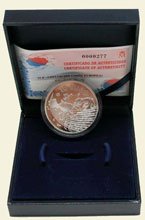 Aufnahme von 10 weiteren Länder in die Europäische Union (Estonia, Latvia, Poland, Hungary, Czech Republic, Lithuania, Slovakia, Slovenia, Malta, and Cyprus) |
Spanien 2005
Thema60 Jahre Frieden und Freiheit in Europa - 60 Years Peace and FreedomDesignAlfonso Morales Múñoz (Rückseite)Vorderseite – ObverseSeitliche Porträt König Juan Carlos I.Umschrift: JUAN CARLOS I REY DE ESPAÑA 2005 Rückseite – ReverseZentrales Motiv: Bildnis der Karte der erweiterten Europäischen Union vor der eine Handreichung stattfindetInschrift: PAZ Y LIBERTAD (Frieden und Freiheit) Wertangabe: 10 EURO Münzzeichen: Gekröntes "M" für die Münzstätte Fábrica Nacional de Monedia y Timbre / Real Casa de la Moneda, Madrid Beizeichen: Europastern  Rand – EdgeRiffelrand – reeded edgeStempelstellung – Orientationgleichgerichtet – penninglagImages - Information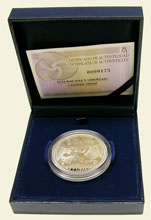 Der Anlass "60 Jahre Ende des Zweiten Weltkriegs" (an dem das Land selbst nicht beteiligt war) wird nich direkt benannt sondern nur das Gemeinschaftsmotto "Paz y Libertad" (Frieden und Freiheit). Der Anlass "60 Jahre Ende des Zweiten Weltkriegs" (an dem das Land selbst nicht beteiligt war) wird nich direkt benannt sondern nur das Gemeinschaftsmotto "Paz y Libertad" (Frieden und Freiheit).Spanien - obwohl es vom faschistischen Franco regiert wurde - stand Deutschland als auch den Alliierten offiziell neutral gegenüber. Hitler hatte durchaus Interesse, Spanien als Partner mit ins eigene Boot zu nehmen. Seine Hoffnung beruhte darauf, mit spanischer Unterstützung das unter britischer Herrschaft stehende Gibraltar einzunehmen und damit freien Zugang ins Mittelmeer zu haben. Deshalb traf Hitler am 23. Oktober 1940 Franco bei Hendaye an der französisch-spanischen Grenze und schlug er ihm vor, an der Seite Deutschlands in den Krieg zu ziehen. Hitler bot Franco dafür sogar Kolonialgebiete in Nordafrika an. Doch der Vorschlag des deutschen Diktators stieß bei Franco auf wenig Interesse: Der spanische Staatschef fürchtete nämlich, dass im Falle eines Kriegseintritts seines Landes die Kanarischen Inseln und die Küstenbereiche Spaniens - auch die Balearen - leicht durch die überlegenen britischen Streitkräfte eingenommen werden könnten. Also lehnte Franco das Angebot der Nazi-Regierung ab. Hitler musste offenbar zähneknirschend die Heimreise antreten. Auf der anderen Seite aber sympathisierten zahlreiche Spanier mit dem NS-Regime und zogen unter dem Namen »Blaue Division« an die Ostfront (1941/43). Dieses Freiwilligen-Corps mussten die Spanier zwar unter britischem Druck 1943 aufgeben. Doch kurz darauf bildete sich die »Spanische Legion«, die bis zum Kriegsende kämpfte. |
Spanien 2006
ThemaGroße Europäer — Great EuropeansKaiser Karl V.DesignEsther Conzáles (Rückseite)Vorderseite – ObverseSeitliche Porträt König Juan Carlos I.Umschrift: JUAN CARLOS I REY DE ESPAÑA 2006 Rückseite – ReverseIllustration Kaiser Karl V. (1500 — 1558) König von Spaniene als Carlos I. Inschrift: CAROLVS IMPERATORDie Illustriation ist aus der Handschrift vom "Goldenen Vlies" aus dem Bestand des Instututo de Valencia de Don Juan in Madrid Münzzeichen: Gekröntes "M" für die Münzstätte Fábrica Nacional de Monedia y Timbre / Real Casa de la Moneda, Madrid Beizeichen: Europastern  Wertangabe: 10 EURO Rand – EdgeRiffelrand – reeded edgeStempelstellung – Orientationgleichgerichtet – penninglagImages - Information  Karl V. (* 24. Februar 1500 in Gent; † 21. September 1558 im Kloster San Jerónimo de Yuste, Extremadura) aus dem Hause Habsburg, war von 1516 an König Karl I. von Spanien (spanisch Carlos I). Mit seiner Wahl im Jahre 1519 wurde er zunächst Römisch-deutscher König, er nannte sich aber nach seiner Krönung im Jahre 1520 "erwählter" Kaiser des Heiligen Römischen Reiches. Im Jahre 1530 wurde er offiziell, als letzter römisch-deutscher Kaiser, durch den Papst zum Kaiser gekrönt. Am 23. August 1556 verzichtete er zugunsten seines Sohnes Philipp II. auf den spanischen Thron und zugunsten seines Bruders Ferdinand I. auf die Kaiserwürde. Karl V. verfolgte das Konzept der Universalmonarchie. Dem Kaiser kam danach Vorrang vor allen übrigen Königen zu. Er verstand sich als Friedenswahrer in Europa, Schützer des Abendlandes vor den Osmanen und sah sich zuständig für den Schutz und die Reform der Kirche. Um dieses Konzept durchsetzen zu können, kämpfte Karl mit Franz I. von Frankreich, der ähnlich dachte, um die Vorherrschaft in Europa. Er konnte sich dabei finanziell auch auf die neuen Kolonien in Übersee stützen. Er war zwar der mächtigste Herrscher in Europa, aber sein Ziel einer dauerhaften Schwächung, des zeitweise mit den Osmanen verbündeten Frankreichs, konnte er nicht erreichen. Im Heiligen Römischen Reich ging es ihm darum, das monarchische gegenüber dem ständischen Prinzip zur Vorherrschaft zu bringen. Zu seiner Zeit wurden für die kommenden Jahrhunderte wichtige Reichsgesetze erlassen. Darunter war etwa die nach ihm benannte Constitutio Criminalis Carolina. Er scheiterte aber mit dem Versuch, die kaiserliche Macht gegenüber den Reichsständen nachhaltig zu stärken. Dies hing auch damit zusammen, dass in seiner Zeit mit der Reformation ein neuer Großkonflikt im Reich entstand, der sich teilweise mit den ständischen Kräften verband. Karl V., oft durch Kriege abwesend, konnte die Ausbreitung der Reformation nicht verhindern. Zeitweise zielte er auf eine Überwindung der Spaltung ab. Er hat gegenüber dem Papst die Einberufung des Konzils von Trient durchgesetzt, dass aber nicht zur Versöhnung der Religionsparteien, sondern nach Karls Tod mit der Reform des Katholizismus zum Ausgangspunkt der Gegenreformation wurde. Nachdem seine Ausgleichsbemühungen mit den Protestanten gescheitert waren, versuchte er nach dem Sieg im Schmalkaldischen Krieg mit dem Augsburger Interim den Reichsständen eine Lösung des Religionskonflikts aufzuzwingen. In dem daraufhin ausbrechenden Fürstenaufstand wurde er gezwungen mit dem Augsburger Religionsfrieden ein Nebeneinander der Konfessionen zu akzeptieren. Karl trat resigniert von seinen Herrscherämtern zurück und zog sich völlig zurück. Zuvor hatte er noch die Nachfolge dergestalt geregelt, dass es zur Aufteilung seines Reiches zwischen der spanischen und der österreichischen Linie der Habsburger kam. 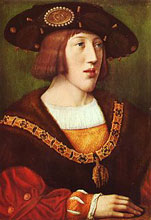 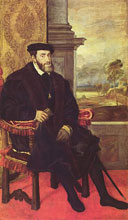 Charles V (Spanish: Carlos I, German: Karl V., Italian: Carlo Quinto, Dutch: Karel V, French: Charles Quint; 24 February 1500 – 21 September 1558) was ruler of the Holy Roman Empire from 1519 and, as Charles I, of the Spanish Empire from 1516 until his voluntary retirement and abdication in favor of his younger brother Ferdinand I and his son Philip II in 1556. As the heir of three of Europe's leading dynasties — the House of Habsburg of the Habsburg Monarchy; the House of Valois-Burgundy of the Burgundian Netherlands; and the House of Trastámara of Crown of Castile-León < Aragon — he ruled over extensive domains in Central, Western, and Southern Europe; and the Spanish colonies in North, Central, and South America, the Caribbean, and Asia. Charles was the eldest son of Philip the Handsome and Joanna of Castile. When Philip died in 1506, Charles became ruler of the Burgundian Netherlands, and his mother's co-ruler in Spain upon the death of his maternal grandfather, Ferdinand the Catholic, in 1516. As Charles was the first person to rule Castile-León and Aragon simultaneously in his own right, he became the first King of Spain (Charles co-reigned with his mother Joanna, which was however a technicality given her mental instability). In 1519, Charles succeeded his paternal grandfather Maximilian as Holy Roman Emperor and Archduke of Austria. From that point forward, Charles's realm, which has been described as "the empire on which the sun never sets", spanned nearly four million square kilometers across Europe, the Far East, and the Americas. Much of Charles' reign was devoted to the Italian Wars against the French king, Francis I, and his heir, king Henry II, which although enormously expensive, were militarily successful due to the undefeated Spanish tercio and the efforts of his prime ministers Mercurino Gattinara and Francisco de los Cobos y Molina. Charles' forces re-captured both Milan and Franche-Comté from France after the decisive Habsburg victory at the Battle of Pavia in 1525, which pushed Francis to form the Franco-Ottoman alliance. Charles' rival Suleiman the Magnificent conquered Hungary in 1526 after defeating the Christians at the Battle of Mohács. However, the Ottoman advance was halted after they failed to capture Vienna in 1529. Aside from this, Charles is best known for his role in opposing the Protestant Reformation. In addition to the German Peasants' War against the Empire, several German princes abandoned the Catholic Church and formed the Schmalkaldic League in order to challenge Charles' authority with military force. Unwilling to allow the same religious wars to come to his other domains, Charles pushed for the convocation of the Council of Trent, which began the Counter-Reformation. The Society of Jesus was established by St. Ignacio de Loyola during Charles' reign in order to peacefully and intellectually combat Protestantism, and continental Spain was spared from religious conflict largely by Charles' nonviolent measures. In Germany, although the Protestants were personally defeated by Charles at the Battle of Mühlberg in 1547, he legalized Lutheranism within the Holy Roman Empire with the Peace of Augsburg. Charles also maintained his alliance with Henry VIII of England, despite the latter splitting the Church of England from Rome and violently persecuting Catholics. In the New World, Charles oversaw the Spanish colonization of the Americas, including the conquest of both the Aztec Empire and the Inca Empire. The rapid Christianization of New Spain was attributed to the miracle of Our Lady of Guadalupe. Uncomfortable with how his viceroys were governing the Americas vis-à-vis the Native Americans, Charles consulted figures such as Francisco de Vitoria and Bartolomé de las Casas on the morality of colonization. He also provided five ships to Ferdinand Magellan and his navigator Juan Sebastián Elcano, after the Portuguese captain was repeatedly turned down by Manuel I of Portugal. The commercial success of Magellan's voyage (the first circumnavigation of the Earth) temporarily enriched Charles by the sale of its cargo of cloves and laid the foundation for the Pacific oceanic empire of Spain, and along with Ruy López de Villalobos, began Spanish colonization of the Philippines. Though always at war, Charles was essentially a lover of peace, and all his wars were virtually defensive. "Not greedy of territory", wrote Marcantonio Contarini in 1536, "but most greedy of peace and quiet." Charles retired in 1556. The Habsburg Monarchy passed to Charles' younger brother Ferdinand, whereas the Spanish Empire was inherited by his son Philip II. The two empires would remain allies until the 18th century. 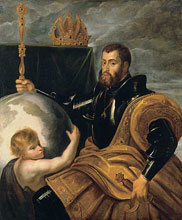  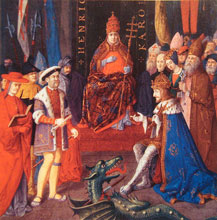 |
Spanien 2007
ThemaEuropäische Errungenschaften – European Achievements50 Jahre Römische VerträgeDesignAlfonso Morales Múñoz (Bildseite)Vorderseite – ObverseSeitliche Porträt König Juan Carlos I.Umschrift: JUAN CARLOS I REY DE ESPAÑA 2007 Rückseite – ReverseKarte der Europäischen Union mit Kennzeichnung der sechs GründungsmitgliedernInschrift: 50 ANIVERSARIO EUROPA TRATADO DE ROMA Münzzeichen: Gekröntes "M" für die Münzstätte Fábrica Nacional de Monedia y Timbre / Real Casa de la Moneda, Madrid Beizeichen: Europastern Wertangabe: 10 EURO Rand – EdgeRiffelrand – reeded edgeStempelstellung – Orientationgleichgerichtet – penninglagImages - Information Die Römischen Verträge (in Österreich Vertrag von Rom genannt) wurden am 25. März 1957 von Belgien, der Bundesrepublik Deutschland, Frankreich, Italien, Luxemburg und den Niederlanden in Rom (Kapitol, Senatorenpalast) unterzeichnet. Zu ihnen gehörten der EWG-Vertrag, mit dem die Europäische Wirtschaftsgemeinschaft (EWG) errichtet wurde, der EURATOM-Vertrag, mit dem die Europäische Atomgemeinschaft (EURATOM) gegründet wurde, und das Abkommen über gemeinsame Organe für die Europäischen Gemeinschaften, das festlegte, dass EWG, EURATOM und EGKS eine gemeinsame parlamentarische Versammlung (jetzt Europäisches Parlament), einen gemeinsamen Gerichtshof und einen gemeinsamen Wirtschafts- und Sozialausschuss haben. Die Verträge traten am 1. Januar 1958 in Kraft. Die genannten Gemeinschaften bildeten zusammen mit der Europäischen Gemeinschaft für Kohle und Stahl die Europäischen Gemeinschaften. Erst mit dem Fusionsvertrag (1965) wurden auch die Kommissionen und die Ministerräte zusammengelegt. Am 12. Juni 1985 wurde in Madrid der Beitritt Spaniens und Portugals zur Europäischen Gemeinschaft (EG) feierlich unterzeichnet. Beide Länder erlangten am 1. Januar 1986 die Vollmitgliedschaft. Damit wurde ein 1977 eingeleiteter Entwicklungsprozess abgeschlossen. Dieser ging auf das Beitrittsgesuch durch das erste demokratische Parlament nach dem Tod Francos (1975) zurück. The Treaty of Rome, officially the Treaty establishing the European Economic Community, was an international agreement that led to the founding of the European Economic Community on 1 January 1958. It was signed on 25 March 1957 by Belgium, France, Italy, Luxembourg, the Netherlands and West Germany. The word Economic was deleted from the treaty's name by the Maastricht Treaty in 1993, and the treaty was repackaged as the Treaty on the functioning of the European Union on the entry into force of the Treaty of Lisbon in 2009. The TEEC proposed the progressive reduction of customs duties and the establishment of a customs union. It proposed to create a common market of goods, workers, services and capital within the EEC's member states. It also proposed the creation of common transport and agriculture policies and a European social fund. It also established the European Commission. The accession of Spain and Portugal to the European Community (EC) was solemnly signed in Madrid on 12 June 1985. Both countries gained full membership on 1 January 1986. Thus, a 1977 initiated development process has been completed. (1975), It went back to the membership through the first democratic Parliament after Franco's death. |
Spanien 2008
ThemaKulturelles Erbe Europas – European Cultural HeritageAdolfo X.Designcoming soonVorderseite – ObverseSeitliche Porträt König Juan Carlos I.Umschrift: JUAN CARLOS I REY DE ESPAÑA 2008 Rückseite – ReverseAlfonso X. »der Weise« (1221 — 1284), König von Kastilien ab 1252, nach einer Statute (1892) von José Alkoverro vor der Spanischen Nationalbiliothek in MadridLatentbild:linke Seite  Gekröntes "M" und "08" (Ausgabejahr) Besonderheit : Neu in diesem Jahr ist ein Latentbild in dem das Münzzeichen der Moeda und das Ausgabejahr im Wechsel zu sehen ist. Münzzeichen: rechte Seite Gekröntes "M" für die Münzstätte Fábrica Nacional de Monedia y Timbre / Real Casa de la Moneda, Madrid Beizeichen: Europastern Wertangabe: 10 EURO Rand – EdgeRiffelrand – reeded edgeStempelstellung – Orientationgleichgerichtet – penninglagImages - Information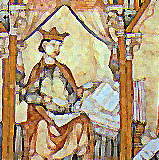 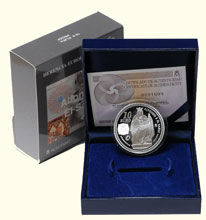 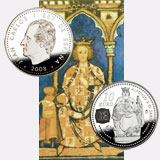 Alfons X., genannt der Weise (El Sabio) (* 23. November 1221 in Toledo; † 4. April 1284 in Sevilla), war König von Kastilien und León von 1252 bis 1282 und von 1257 bis 1273 (1284) König (Gegenkönig) des Heiligen Römischen Reiches. Er war der erste Sohn von Ferdinand III. dem Heiligen und Elisabeth (genannt Beatrix von Spanien), einer Tochter des deutschen Königs Philipp von Schwaben. Er ist einer der interessantesten, wenn auch bei weitem nicht der fähigste der spanischen Könige des Mittelalters. Sein beträchtlicher wissenschaftlicher Ruf basiert darauf, dass er sowohl der Verfasser mehrerer größerer Gedichte sowie eines chemischen und eines philosophischen Werkes war, als auch die Astronomie und die Anerkennung der ptolemäischen Kosmologie förderte, die ihm durch die Mauren (Araber) bekannt geworden waren. So ließ er für 40.000 Dukaten die Ptolemäischen Planetentafeln verbessern, welche nach ihm die Alfonsinischen Tafeln genannt wurden (1252). Der Alfonskrater auf dem Mond ist nach ihm benannt. Er gründete in Toledo eine Übersetzerschule aus Juden, Moslems und Christen, die große Leistungen in der Vermittlung arabischen und jüdischen Wissens ins christliche Europa vollbrachte. Hier wurden sowohl das Alte Testament aus der lateinischen Fassung der Vulgata ins Spanische übersetzt als auch klassische Werke über Astronomie, Mathematik und Philosophie. Alfons gilt als der Begründer der kastilischen Nationalliteratur. Er ließ von seinen Historiographen die erste allgemeine Geschichte von Spanien in kastilischer Sprache zusammenstellen und die öffentlichen Urkunden in der Landessprache abfassen.  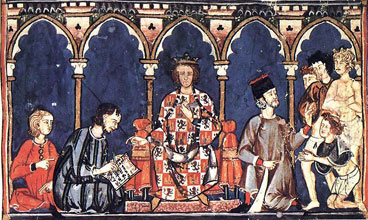 Alfonso X (23 November 1221 – 4 April 1284) was a Castilian monarch who ruled as the King of Castile, León and Galicia from 1252 until his death. He also was elected King of the Germans in 1257. He established Castilian as a language of higher learning and earned his nicknames "the Wise" or "the Learned" (Spanish: 'el Sabio', Galician: 'O Sabio') and "the Astrologer" (Spanish: 'el Astrólogo', Galician: 'O Astrólogo') through his own prolific writings, including Galician poetry. Born in Toledo, Spain, Alfonso was the eldest son of Ferdinand III of Castile and Elisabeth of Hohenstaufen, known in Spain as Beatriz de Suabia, through whom he was a cousin of Frederick II, Holy Roman Emperor, to whom Alfonso is often compared. His maternal grandparents were Philip of Swabia and Irene Angelina. Not much is known about his upbringing, but he was most likely raised in Toledo. He began his career as a soldier, under the command of his father, when he was only sixteen years old. After the election of Theobald I as king of Navarre, his father tried to arrange a marriage for Ferdinand with Theobald's daughter, Blanche of Navarre, but the move was unsuccessful. So, in 1240, he married Maior Guillen de Guzman, but the marriage was later annulled and their issue declared illegitimate. In the same period (1240–1250) he conquered several Muslim strongholds in Al-Andalus alongside his father, such as Murcia, Alicante and Cadiz. |
Spanien 2009
ThemaKulturelles Erbe Europas – European Cultural HeritageKönig Phillip II. von SpanienDesigncoming soonVorderseite – ObverseSeitliche Porträt König Juan Carlos I.Umschrift: JUAN CARLOS I REY DE ESPAÑA 2009 Rückseite – ReverseHauptmotiv:Rechte Seite: Replikat eine Büste von König Philip II entnommen ein Porträt, gemalt von Tizian. Linke Seite: Wappen über dem Eingang des Königlichen Sitz Sankt Laurentius von El Escorial (Real Sitio de San Lorenzo de El Escorial) Inschrift: Recht Oben: FELIPE II Münzzeichen: Gekröntes "M" für die Münzstätte Fábrica Nacional de Monedia y Timbre / Real Casa de la Moneda, Madrid Beizeichen: Europastern Wertangabe: 10 EURO Rand – EdgeRiffelrand – reeded edgeStempelstellung – Orientationgleichgerichtet – penninglagImages - Information  Der Real Sitio de San Lorenzo de El Escorial (Königlicher Sitz Sankt Laurentius von El Escorial) ist eine Schloss- und Klosteranlage, die in den Jahren 1563 bis 1584 auf Initiative des Königs Philipp II. von Spanien nach Plänen von Juan Bautista de Toledo in der spanischen Ortschaft San Lorenzo de El Escorial in der Region Madrid errichtet wurde. Die Entfernung zur spanischen Hauptstadt beträgt etwa 45 Kilometer. Das Schloss ist der größte Renaissancebau der Welt. The Royal Seat of San Lorenzo de El Escorial is a historical residence of the king of Spain, in the town of San Lorenzo de El Escorial, about 45 kilometres (28 mi) northwest of the capital, Madrid, in Spain. It is one of the Spanish royal sites and functions as a monastery, royal palace, museum, and school. It is also known shorthand as El Escorial or the Escorial. 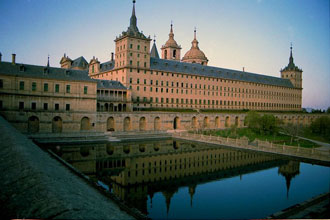 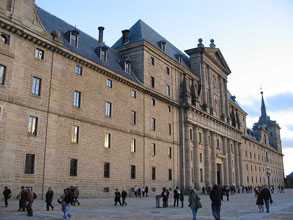 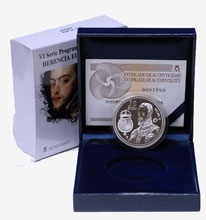 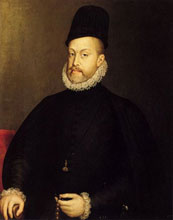 Philipp II. (spanisch Felipe II, * 21. Mai 1527 in Valladolid; † 13. September 1598 im Palast El Escorial bei Madrid) erbte als ältester und einzig überlebender legitimer Sohn Karls V. (Karl I. von Spanien) und Isabellas von Portugal 1556 das Königreich von Spanien, die amerikanischen Kolonien, die Niederlande, die Freigrafschaft Burgund, das Königreich beider Sizilien, das Königreich Sardinien und das Herzogtum Mailand. Nach ihm benannte Ruy López de Villalobos 1543 zuerst die Insel Leyte als "Las Islas Filipinas", eine Bezeichnung, die später auf den gesamten Archipel ausgeweitet wurde und dem Inselstaat der Philippinen ihren Namen gab. 1580 wurde er als Philipp I. auch König von Portugal. England Nach Marias Tod am 12. Juli 1545 strebte er vorerst neuerlich eine Heirat mit einer Portugiesin an, heiratete jedoch auf dringlichen Wunsch seines Vaters, der ein Bündnis mit England anstrebte, am 25. Juli 1554 die katholische Königin Maria I. von England – die Cousine seines Vaters, also seine Tante zweiten Grades – auch als Maria Tudor oder Bloody Mary bekannt. Diese Ehe war bei ihren Untertanen unbeliebt und, soweit es Philipp betraf, eine rein politische Allianz. Während der Dauer der Ehe führte er den Titel König von England. Am 16. Januar 1556 folgte Philipp nach der Abdankung seines Vaters Karl auf den spanischen Thron. Nachdem seine zweite Frau, Maria Tudor, 1558 kinderlos gestorben war, machte Philipp ihrer jüngeren Schwester Elisabeth I. von England Avancen, doch sein Plan schlug aus einer ganzen Reihe von Gründen fehl. "Meine Schwester hat durch die Heirat mit Euch die Gunst ihres Volkes verspielt, glaubt ihr ich werde denselben Fehler machen?"  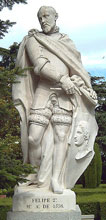  Philip II (Spanish: Felipe II; Portuguese: Filipe I ; 21 May 1527 – 13 September 1598) was King of Spain, Portugal, Naples, Sicily, and, while married to Mary I, King of England and Ireland. He was lord of the Seventeen Provinces from 1556 until 1581, holding various titles for the individual territories such as duke or count. Also known as Philip the Prudent, he ruled one of the world's largest empires which included territories in every continent then known to Europeans. Philip was born in Valladolid, the son of Charles V of the Holy Roman Empire, and his consort, Isabella of Portugal. During his reign, Spain was the foremost Western European power. Under his rule, Spain reached the height of its influence and power, directing explorations all around the world and settling the colonization of territories in all the known continents. He was described by the Venetian ambassador Paolo Fagolo in 1563 as "slight of stature and roundfaced, with pale blue eyes, somewhat prominent lip, and pink skin, but his overall appearance is very attractive." The Ambassador went on to say "He dresses very tastefully, and everything that he does is courteous and gracious."  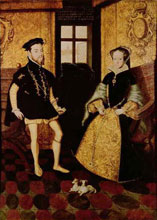 King of England and Ireland Philip's father arranged his marriage to 37-year old Queen Mary I of England. In order to elevate Philip to Mary's rank, his father ceded the crown of Naples, as well as his claim to the Kingdom of Jerusalem, to him. Their marriage at Winchester Cathedral on 25 July 1554 took place just two days after their first meeting. Philip's view of the affair was entirely political. Lord Chancellor Gardiner and the House of Commons petitioned Mary to consider marrying an Englishman, fearing that England would be relegated to a dependency of Spain. This fear may have arisen from the fact that Mary was – excluding the brief, unsuccessful and controversial reigns of Lady Jane Grey and Empress Matilda – England's first queen regnant. Under the terms of the marriage treaty, Philip was to enjoy Mary I's titles and honours for as long as their marriage should last. All official documents, including Acts of Parliament, were to be dated with both their names, and Parliament was to be called under the joint authority of the couple. Coins were also to show the heads of both Mary and Philip. The marriage treaty also provided that England would not be obliged to provide military support to Philip's father in any war. The Privy Council instructed that Philip and Mary should be joint signatories of royal documents, and this was enacted by an Act of Parliament, which gave him the title of king and stated that he "shall aid her Highness ... in the happy administration of her Grace's realms and dominions."[12] In other words, Philip was to co-reign with his wife. As the new King of England could not read English, it was ordered that a note of all matters of state should be made in Latin or Spanish. Acts which made it high treason to deny Philip's royal authority were passed in Ireland and England. Philip and Mary appeared on coins together, with a single crown suspended between them as a symbol of joint reign. The Great Seal shows Philip and Mary seated on thrones, holding the crown together. The coat of arms of England was impaled with Philip's to denote their joint reign. Philip's wife had succeeded to the Kingdom of Ireland, but the title of King of Ireland was created in 1542 by Henry VIII after he was excommunicated, so it was not recognised by Catholic monarchs. In 1555, Pope Paul IV rectified this by issuing a Papal Bull recognizing Philip and Mary as rightful King and Queen of Ireland.[20] Their joint royal style after Philip ascended the Spanish throne in 1556 was: Philip and Mary, by the Grace of God King and Queen of England, Spain, France, Jerusalem, both the Sicilies and Ireland, Defenders of the Faith, Archdukes of Austria, Dukes of Burgundy, Milan and Brabant, Counts of Habsburg, Flanders and Tirol. However, they had no children. Mary died in 1558 before the union could revitalize the Roman Catholic Church in England. With her death, Philip lost his rights to the English throne and ceased being King of England and Ireland. After Mary I's death Upon Mary's death, the throne went to Elizabeth I. Philip had no wish to sever his tie with England, and had sent a proposal of marriage to Elizabeth. However, she delayed in answering, and in that time learned Philip was also considering a Valois alliance. Elizabeth was the Protestant daughter of Henry VIII and Anne Boleyn. This union was deemed illegitimate by English Catholics who did not recognize Henry's divorce and who claimed that Mary, Queen of Scots, the Catholic great granddaughter of Henry VII, was the legitimate heir to the throne. For many years Philip maintained peace with England, and had even defended Elizabeth from the Pope's threat of excommunication. This was a measure taken to preserve a European balance of power. Ultimately, Elizabeth allied England with the Protestant rebels in the Netherlands. Further, English ships began a policy of piracy against Spanish trade and threatened to plunder the great Spanish treasure ships coming from the new world. English ships went so far as to attack a Spanish port. The last straw for Philip was the Treaty of Nonsuch signed by Elizabeth in 1585 - promising troops and supplies to the rebels. Although it can be argued this English action was the result of Philip's Treaty of Joinville with the Catholic League of France, Philip considered it an act of war by England. The execution of Mary, Queen of Scots in 1587 ended Philip's hopes of placing a Catholic on the English throne. He turned instead to more direct plans to invade England, with vague plans to return the country to Catholicism. In 1588, he sent a fleet, the Spanish Armada, to rendezvous with the Duke of Parma's army and convey it across the English Channel. However, the operation had little chance of success from the beginning, because of lengthy delays, lack of communication between Philip II and his two commanders and the lack of a deep bay for the fleet. At the point of attack, a storm struck the English Channel, already known for its harsh currents and choppy waters, which devastated large numbers of the Spanish fleet. There was a tightly fought battle against the English navy; it was by no means a slaughter, but the Spanish were forced into a retreat. Eventually, three more Armadas were assembled; two were sent to England in 1596 and 1597, but both also failed; the third (1599) was diverted to the Azores and Canary Islands to fend off raids. This Anglo-Spanish War (1585–1604) would be fought to a grinding end, but not until both Philip II (d. 1598) and Elizabeth I (d. 1603) were dead. The defeat of the Spanish Armada gave great heart to the Protestant cause across Europe. The storm that smashed the armada was seen by many of Philip's enemies as a sign of the will of God. Many Spaniards blamed the admiral of the armada for its failure, but Philip, despite his complaint that he had sent his ships to fight the English, not the elements, was not among them. |
Spanien 2010
ThemaArchitektur in Europa – Architecture in EuropeAntonio Gaudi und die Sühnekirche der heiligen FamilieDesigncoming soonVorderseite – ObverseUmschrift: JUAN CARLOS I REY DE ESPAÑA 2010Rückseite – ReverseZentrales Motiv: Die Sagrada Família (Temple Expiatori de la Sagrada Família) in Barcelona.Linke Seite: Abbild von Antoni Gaudí 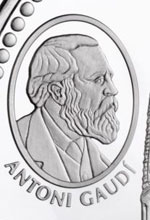 Münzzeichen: Gekröntes "M" für die Münzstätte Fábrica Nacional de Monedia y Timbre / Real Casa de la Moneda, Madrid Beizeichen: Europastern  Wertangabe: 10 EURO Rand – EdgeRiffelrand – reeded edgeStempelstellung – Orientationgleichgerichtet – penninglagImages - Information  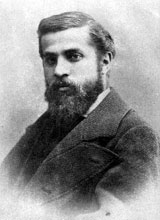 Antoni Gaudí i Cornet; * 25. Juni 1852 in Reus, möglicherweise in Riudoms; † 10. Juni 1926 in Barcelona), war ein katalanischer Architekt und herausragender Vertreter des Modernisme Català. Die Sagrada Família (vollständige katalanische Bezeichnung: Temple Expiatori de la Sagrada Família; deutsch Sühnekirche der Heiligen Familie) ist eine römisch-katholische Basilika in Barcelona. Der Bau der von Antoni Gaudí im neukatalanischen Stil entworfenen Kirche ist bis heute unvollendet. Er wurde 1882 begonnen und soll nach jüngsten Prognosen 2026 abgeschlossen sein. Im Jahr 2005 nahm die UNESCO die Geburtsfassade, die Apsisfassade und die Krypta der Sagrada Família als Erweiterung des Weltkulturerbedenkmals Arbeiten von Antoni Gaudí in ihre Liste des Weltkulturerbes auf. Am 7. November 2010 weihte Papst Benedikt XVI. die Kirche und erhob sie zugleich zur päpstlichen Basilica minor. Das Gotteshaus liegt nördlich der Altstadt im Stadtteil Eixample. In diesem schachbrettartig angelegten Viertel nimmt sie zusammen mit der Baustelle einen ganzen, 17.822,25 Quadratmeter großen Straßenblock ein. Dieser grenzt im Süden an die Carrer de Mallorca, im Norden an die Carrer de Provença, im Westen an die Carrer de Sardenya und im Osten an die Carrer de Marina. 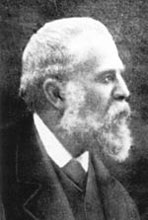 The Basílica i Temple Expiatori de la Sagrada Família, English: Basilica and Expiatory Church of the Holy Family, Spanish: Basílica y Templo Expiatorio de la Sagrada Familia), commonly known as the Sagrada Família, is a large Roman Catholic church in Barcelona, Catalonia, Spain, designed by Catalan architect Antoni Gaudí (1852–1926). Although incomplete, the church is a UNESCO World Heritage Site, and in November 2010 was consecrated and proclaimed a minor basilica by Pope Benedict XVI. Though construction of Sagrada Família had commenced in 1882, Gaudí became involved in 1883, taking over the project and transforming it with his architectural and engineering style—combining Gothic and curvilinear Art Nouveau forms. Gaudí devoted his last years to the project and at the time of his death in 1926, less than a quarter of the project was complete. Sagrada Família's construction progressed slowly as it relied on private donations and was interrupted by the Spanish Civil War only to resume intermittent progress in the 1950s. Construction passed the mid-point in 2010 with some of the project's greatest challenges remaining and an anticipated completion date of 2026—the centennial of Gaudí's death. The basílica has a long history of dividing the citizens of Barcelona—over the initial possibility it might compete with Barcelona's cathedral, over Gaudí's design itself, over the possibility that work after Gaudí's death disregarded his design,[10] and the recent possibility that an underground tunnel of Spain's high-speed train could disturb its stability. Describing Sagrada Familia, art Critic Rainer Zerbst said "it is probably impossible to find a church building anything like it in the entire history of art" and Paul Goldberger called it 'the most extraordinary personal interpretation of Gothic architecture since the Middle Ages'. Antoni Gaudí i Cornet 25 June 1852 – 10 June 1926) was a Spanish Catalan architect and the best-known representative of Catalan Modernism. Gaudí's works are marked by a highly individual style and the vast majority of them are situated in the Catalan capital of Barcelona, including his magnum opus, the Sagrada Família. Much of Gaudí's work was marked by the four passions of his life: architecture, nature, religion and his love for Catalonia. Gaudí meticulously studied every detail of his creations, integrating into his architecture a series of crafts, in which he himself was skilled, such as ceramics, stained glass, wrought ironwork forging and carpentry. He also introduced new techniques in the treatment of the materials, such as his famous trencadís, made of waste ceramic pieces. After a few years under the influence of neo-Gothic art, and certain oriental tendencies, Gaudí became part of the Catalan Modernista movement which was then at its peak, towards the end of the 19th century and the beginning of the 20th. Gaudí's work, however, transcended mainstream Modernisme, culminating in an organic style that was inspired by nature without losing the influence of the experiences gained earlier in his career. Rarely did Gaudí draw detailed plans of his works and instead preferred to create them as three-dimensional scale models, moulding all details as he was conceiving them in his mind. Gaudí's work has widespread international appeal, and there are innumerable studies devoted to his way of understanding architecture. Today he is admired by both professionals and the general public: his masterpiece, the Sagrada Família, is one of the most visited monuments in Spain. Between 1984 and 2005 seven of his works were declared World Heritage Sites by UNESCO. He awakened to his Roman Catholic faith during his life and many religious images can be seen in his works, a fact which has led to his being nicknamed "God's Architect" and calls for him to be beatified. |
Spanien 2011
ThemaEuropäische Entdecker - European ExplorerFrancisco de OrellanaDesigncoming soonVorderseite – ObverseUmschrift: JUAN CARLOS I REY DE ESPAÑA 2010Rückseite – ReverseZentrales Motiv: auf der linken Seite ein Abbild von Francisco de Orellana.rechte Seite: Darstellung des Expeditionsschiffs von Orellana Umschrift unten: FRANCISCO de ORELLANA Münzzeichen:  Beizeichen: Gekröntes "M" für die Münzstätte Fábrica Nacional de Monedia y Timbre / Real Casa de la Moneda, Madrid  Europastern Wertangabe: 10 EURO Rand – EdgeRiffelrand – reeded edgeStempelstellung – Orientationgleichgerichtet – penninglagImages - Information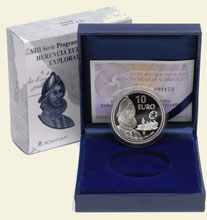   Francisco de Orellana (* 1511 in Trujillo, Spanien; † 1546) war ein spanischer Konquistador, der als erster Europäer den Amazonas von West nach Ost befuhr. Orellana war wahrscheinlich im Jahre 1527 in die Neue Welt gekommen. Als Francisco Pizarro zur Eroberung Perus aufbrach, zog er mit ihm in den Kampf. Beim Sturm auf Cuzco 1533 verlor Orellana ein Auge. Nach der Eroberung des Inkareiches ließ sich Orellana in Portoviejo (im heutigen Ecuador) nieder. Während des Bürgerkrieges zwischen Pizarro und Diego de Almagro kämpfte er auf der Seite Pizarros. Francisco de Orellana (* 1511 in Trujillo, Spanien; † 1546) war ein spanischer Konquistador, der als erster Europäer den Amazonas von West nach Ost befuhr. Orellana war wahrscheinlich im Jahre 1527 in die Neue Welt gekommen. Als Francisco Pizarro zur Eroberung Perus aufbrach, zog er mit ihm in den Kampf. Beim Sturm auf Cuzco 1533 verlor Orellana ein Auge. Nach der Eroberung des Inkareiches ließ sich Orellana in Portoviejo (im heutigen Ecuador) nieder. Während des Bürgerkrieges zwischen Pizarro und Diego de Almagro kämpfte er auf der Seite Pizarros.  Francisco de Orellana, a Spanish explorer and conquistador (1511 - 1546), Orellana was born in Trujillo (Cáceres). He was the first of Spain's explorers to navigate the Amazon. He set out for Central America at the age of 17. Having gained an expert knowledge of the American territory and of several Amerindian tongues, he bolstered Gonzalo Pizarro's army in Peru and assisted him in many campaigns, in one of which he lost an eye. 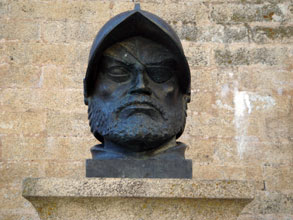 In 1537 he re-founded the city of Guayaquil which had been destroyed by the natives, and in 1538 he received the title of Lieutenant Governor of the city. In 1541 he joined the expedition that Pizarro was organizing to the east in search of the Country of Cinnamon and El Dorado, which would conclude in the discovery of the Amazon river in 1542. He then set course to return to Spain, where he was granted governorship over the lands he had discovered and named New Andalusia. He died in his endeavor to sail the Amazon upstream from the mouth of the river to Quito. The connection between Francisco de Orellana and the name of the Amazon river is of interest, for there are those who will swear that the name was given by Orellana himself in reference to the fierce warrior women of Greek myth, the Amazons, after he had encountered a tribe along this river whose women defended themselves by fighting in the same way as did the men. In 1537 he re-founded the city of Guayaquil which had been destroyed by the natives, and in 1538 he received the title of Lieutenant Governor of the city. In 1541 he joined the expedition that Pizarro was organizing to the east in search of the Country of Cinnamon and El Dorado, which would conclude in the discovery of the Amazon river in 1542. He then set course to return to Spain, where he was granted governorship over the lands he had discovered and named New Andalusia. He died in his endeavor to sail the Amazon upstream from the mouth of the river to Quito. The connection between Francisco de Orellana and the name of the Amazon river is of interest, for there are those who will swear that the name was given by Orellana himself in reference to the fierce warrior women of Greek myth, the Amazons, after he had encountered a tribe along this river whose women defended themselves by fighting in the same way as did the men.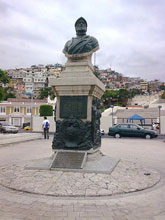  |
Spanien 2012
ThemaEuropäische Künstler - Maler und Bildhauer
Juan Gris |
Spanien 2013
ThemaEuropäische Schriftsteller
Miguel de Cervantes Juan Gris |
Spanien 2014
ThemaEuropäische Komponisten
Manuel de Falla |
Spanien 201
Thema70 Jahre Frieden in Europa |

